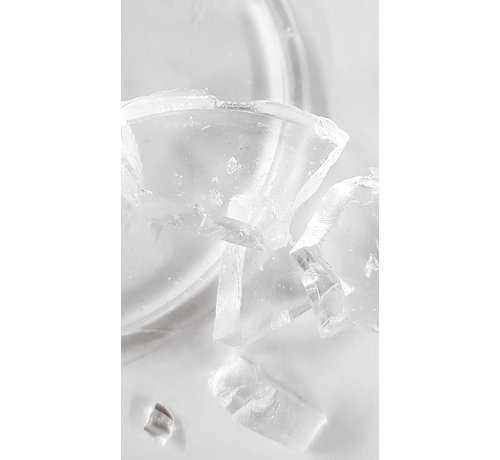Silicone glass effect
- Low shrinkage of <0.1%
- Very fluid and self deaerating
- Crystal clear
- Suitable for potting
- Refr. Index @ 25°C 1.406
Description
The Silicone glass effect is a 2-component (Platinum) addition curing silicone which cures at room temperature. The silicones are, after mixing, very liquid and crystal clear.
Because of the low shrinkage and very good clarity these silicones are ideal for potting of electronics, optical elements or to mimic broken glass.
Technical data
Mixing ratio (weight) | [A: B] | 1: 1 |
Pot Life @ 23°C | [Min] | 1-2 |
De-mould time @ 23°C | [Hours] | 0,25-0,5 |
Viscosity @ 23°C | [cSt] | 100 |
Color |
| crystal clear |
Hardness | [Shore A] | 23-27 |
Density | [g/cm3] | 1 |
Tensil strength | [N/mm2] | Breakable |
Note: Pot life / de-mould time is highly dependent on temperature! At a higher temperature, the processing time and de-mould time are shorter.
Processing
The Silicone glas effect A and B component can easily be mixed by hand or by machine. Mix the A and B component carefully and in the indicated ratio (100 parts A and 100 parts B by weight). Process the mixture within the pot life and demould only after it is cured complete. Alternatively, you can speed up the curing process by placing the whole mould in an oven. Please note that air bubbles will then have less time to escape the casting.
Extra information
Trapping of air bubbles can be prevented best by placing the silicone under vacuum immediately after mixing. To prevent air bubbles, stir the A and B component well but slowly without stirring in air. We advise to use a figur of 8 motion. If you want to reduce the Shore (hardness), you can add silicone oil from the shop. Please note that oil does not bind to the silicone network and may over time bleed from the silicone. You can color these silicones intensely with silicon dye.
The silicon might obtain a very slight yellow hue when used at elevated temperatures (>80 ° C).
Please note: This is an addition curing silicone. This type of silicones may experience cure inhibition when coming into contact with sulfer, nitrogen, amino groups and metl salts. If you are not certain that the products you use (including gloves, spatulas and cups) contain these ingredients, please do a little test first! These components are often found in many latex gloves, some platicines, glues, laquers, condensation curing silicones, silicone caulk, natural rubbers and 3D printing materials (mainly stereolithography).
Durability
Provided that the silicone is in a sealed container and stored cool and frost-free, the shelf life is at least 1 year.
Safety
If you use silicone frequently we advice the use of gloves and to work in a properly ventilated area. For safety information see the safety data sheet.
Product information
 Product information sheet Silicone Glass Effect
Product information sheet Silicone Glass Effect




